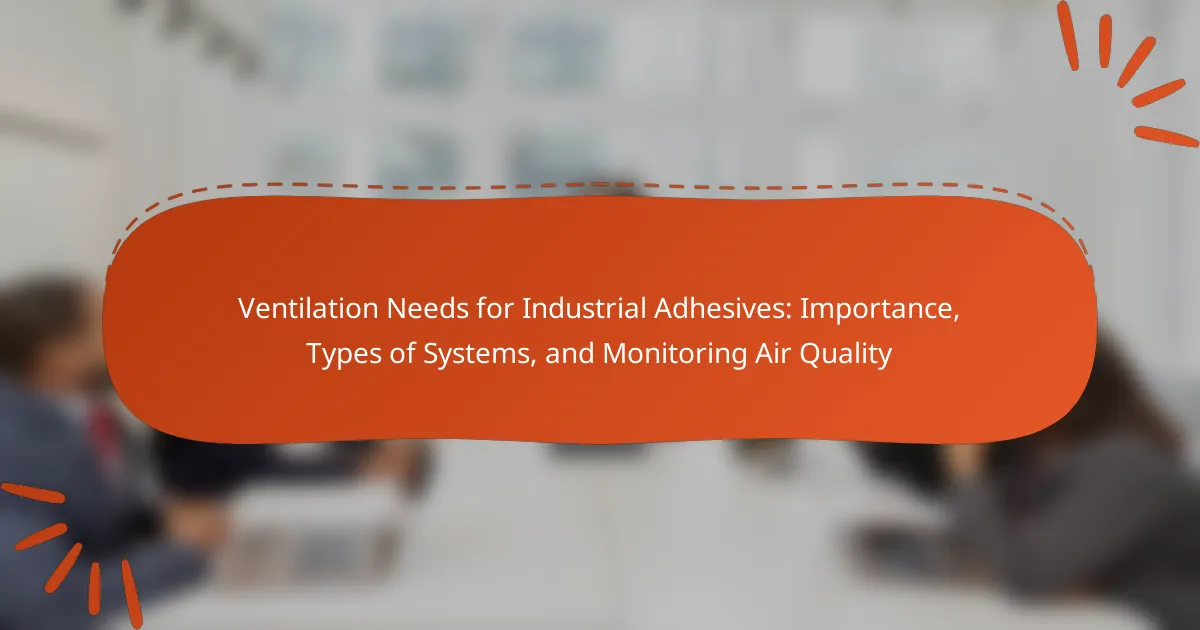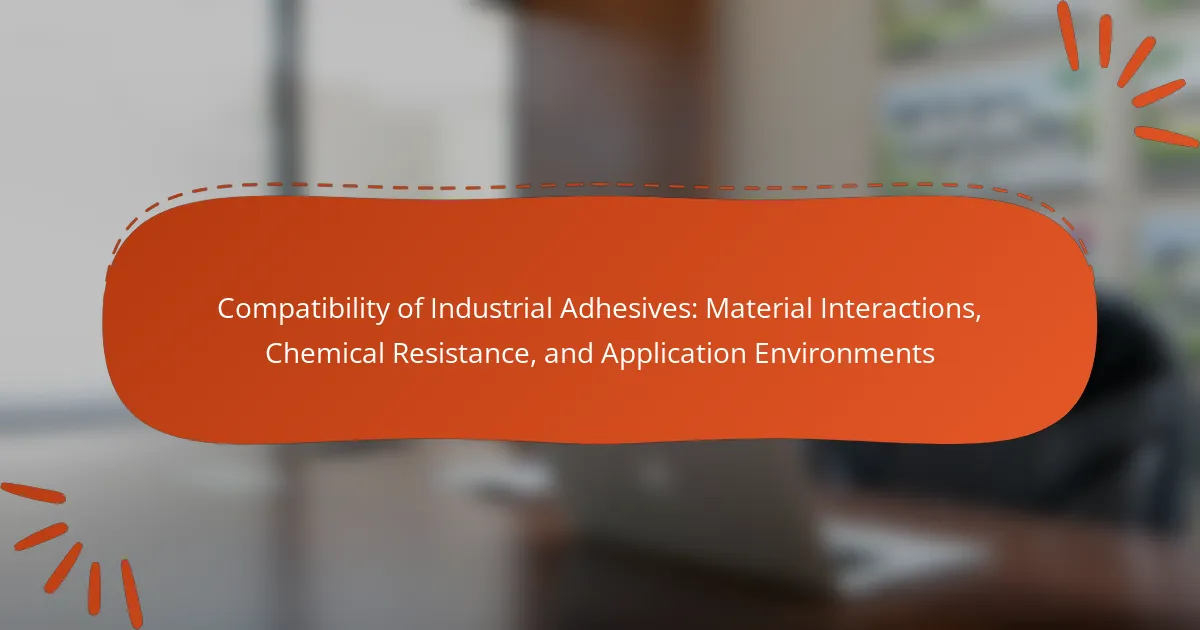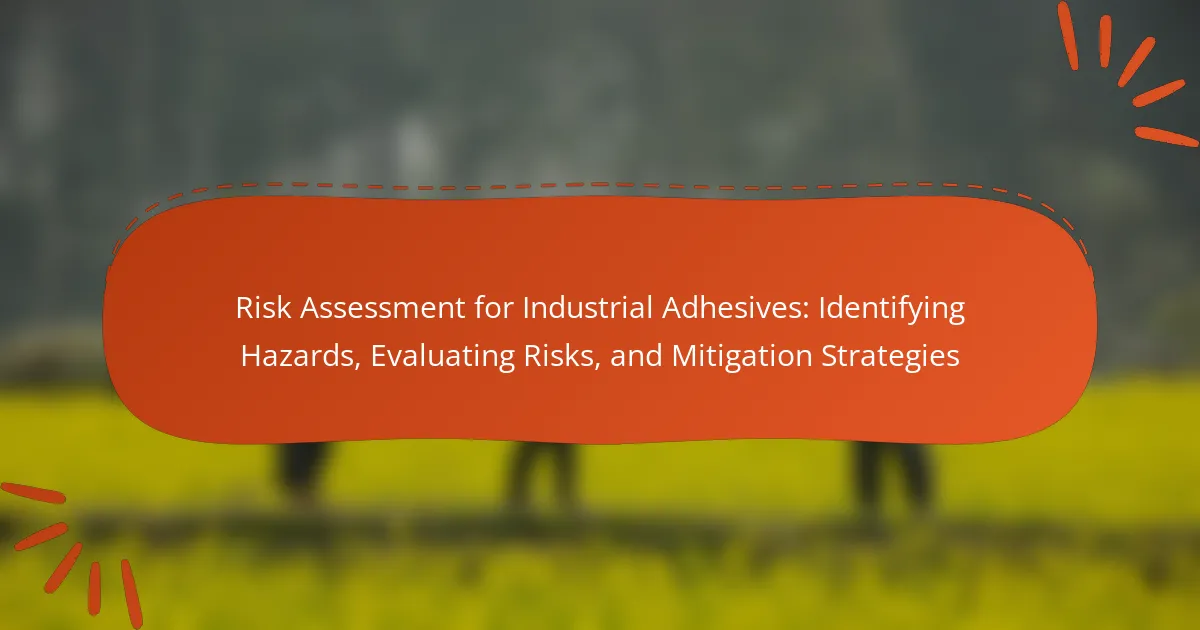Ventilation needs for industrial adhesives are critical for ensuring worker safety and maintaining air quality. Adequate ventilation systems must provide at least six air changes per hour to effectively dissipate harmful fumes and vapors generated during adhesive application. Key factors influencing the choice of ventilation systems include the type of adhesives used, their chemical properties, workspace size and layout, and regulatory compliance with Occupational Safety and Health Administration (OSHA) guidelines. Effective ventilation strategies involve local exhaust systems to capture fumes at the source, general ventilation to dilute contaminants, and regular monitoring of air quality to ensure optimal performance and compliance with safety standards.
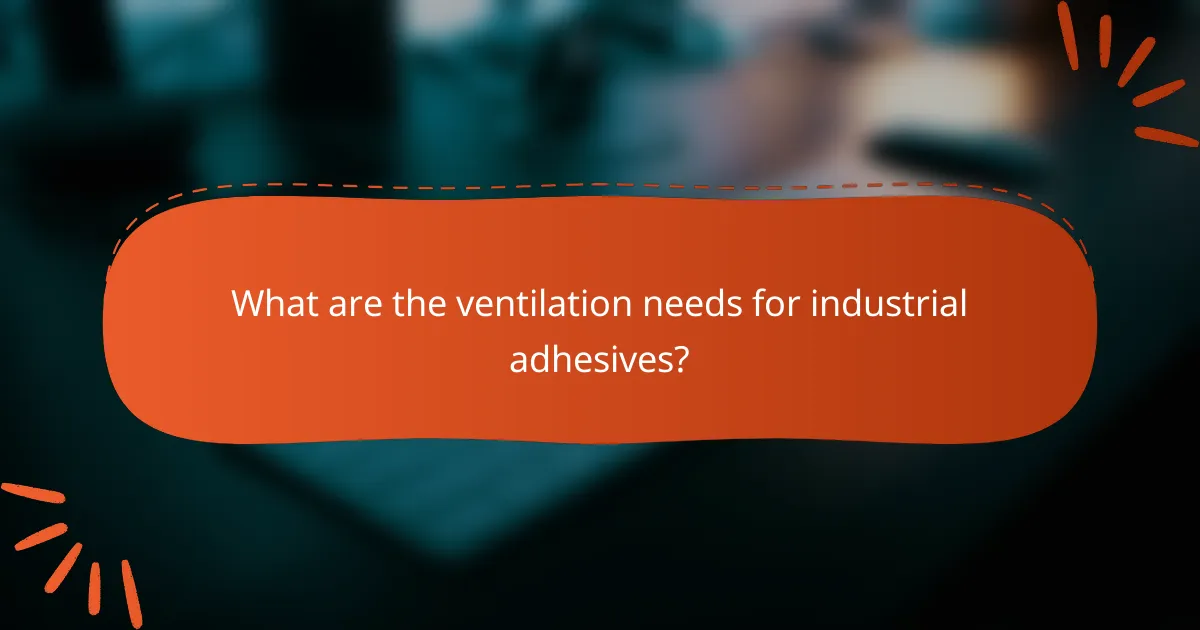
What are the ventilation needs for industrial adhesives?
Industrial adhesives require adequate ventilation to ensure worker safety and maintain air quality. Proper ventilation helps to dissipate harmful fumes and vapors generated during adhesive application. Ventilation systems should be designed to provide a minimum of six air changes per hour in work areas. Local exhaust ventilation is often recommended to capture fumes at the source. Additionally, general ventilation can help dilute contaminants in the air. The Occupational Safety and Health Administration (OSHA) sets guidelines for permissible exposure limits for various adhesive components. Compliance with these guidelines is essential for workplace safety. Regular monitoring of air quality ensures that ventilation systems are functioning effectively.
Why is proper ventilation crucial in industrial adhesive applications?
Proper ventilation is crucial in industrial adhesive applications to ensure worker safety and product quality. It helps to remove harmful fumes and volatile organic compounds emitted during adhesive curing. Inadequate ventilation can lead to respiratory issues for workers exposed to these chemicals. It also prevents the buildup of flammable vapors, reducing the risk of fire hazards. According to the Occupational Safety and Health Administration (OSHA), proper ventilation is essential to maintain air quality standards in workplaces. Additionally, effective airflow can enhance the curing process of adhesives, ensuring optimal bond strength and performance.
What are the health risks associated with inadequate ventilation?
Inadequate ventilation poses several health risks. It can lead to the accumulation of harmful airborne pollutants. These pollutants include volatile organic compounds (VOCs) from industrial adhesives. Prolonged exposure can result in respiratory issues such as asthma and chronic obstructive pulmonary disease (COPD). Insufficient air circulation may also increase the risk of headaches and dizziness. Furthermore, it can contribute to the spread of airborne pathogens. This may result in increased incidences of infections. According to the World Health Organization, poor indoor air quality can lead to significant health problems over time.
How does ventilation impact the performance of industrial adhesives?
Ventilation significantly impacts the performance of industrial adhesives. Adequate ventilation helps control the temperature and humidity levels in application areas. These environmental factors can affect adhesive curing times and bond strength. Improved air circulation reduces the concentration of volatile organic compounds (VOCs) released during adhesive application. High VOC levels can lead to improper adhesion and potential health risks for workers. Studies show that optimal ventilation can enhance adhesive performance by ensuring a stable environment. For instance, a well-ventilated area can lead to faster curing times and better adhesion quality. Proper ventilation systems are essential for maintaining air quality and ensuring effective adhesive performance.
What are the types of ventilation systems used in industrial settings?
The types of ventilation systems used in industrial settings include natural ventilation, mechanical ventilation, and local exhaust ventilation. Natural ventilation relies on wind and temperature differences to circulate air. Mechanical ventilation uses fans and blowers to control airflow. Local exhaust ventilation captures contaminants at their source, improving air quality. Each system serves specific needs based on the industrial environment. For example, mechanical systems are often necessary in enclosed spaces. Local exhaust systems are critical in areas with high pollutant levels. Proper selection enhances worker safety and compliance with health regulations.
What are the differences between natural and mechanical ventilation systems?
Natural ventilation systems rely on natural forces like wind and temperature differences to circulate air. Mechanical ventilation systems use fans and mechanical equipment to control air movement. Natural ventilation is often cost-effective and energy-efficient. However, it may not provide adequate air exchange in all conditions. Mechanical systems can be designed for specific air quality needs, ensuring consistent ventilation. They can filter and condition air, improving indoor air quality. In contrast, natural systems depend on external weather conditions, which can be unpredictable. Studies show that mechanical ventilation can enhance worker safety in industrial settings by reducing exposure to harmful vapors.
How do local exhaust ventilation systems function in adhesive applications?
Local exhaust ventilation systems function by capturing and removing airborne contaminants generated during adhesive applications. These systems utilize hoods placed near the source of emissions. The hoods create a negative pressure zone that draws in vapors and particulates. Ductwork then transports the captured contaminants to a filtration or exhaust point. This process helps maintain air quality in the workspace. Effective local exhaust ventilation reduces the risk of inhalation exposure to harmful substances. According to the Occupational Safety and Health Administration (OSHA), proper ventilation is crucial for worker safety in environments using volatile adhesives.
How can air quality be monitored effectively in adhesive manufacturing?
Air quality in adhesive manufacturing can be monitored effectively using real-time air quality sensors. These sensors measure volatile organic compounds (VOCs), particulate matter, and other pollutants. Regular calibration of the sensors ensures accurate readings. Implementing a continuous monitoring system allows for immediate detection of air quality changes. Data from these sensors can be integrated into a centralized monitoring system. This integration facilitates analysis and reporting of air quality trends. Compliance with occupational safety standards is essential for worker health. Studies show that effective monitoring reduces health risks associated with adhesive manufacturing processes.
What tools and technologies are available for air quality monitoring?
Air quality monitoring tools and technologies include sensors, analyzers, and data management systems. Sensors detect pollutants like particulate matter, gases, and volatile organic compounds. Common types are electrochemical sensors and optical sensors. Analyzers provide detailed measurements of air quality parameters. They often use methods like gas chromatography or mass spectrometry. Data management systems collect and analyze data from sensors and analyzers. These systems can provide real-time monitoring and reporting capabilities. Examples of popular air quality monitoring technologies include the Aeroqual series and the PurpleAir sensors. These devices help in assessing air quality in various environments, including industrial settings.
How often should air quality be assessed in industrial environments?
Air quality should be assessed in industrial environments at least once a year. Regular assessments help identify potential hazards and ensure compliance with safety regulations. The frequency may increase based on specific operations, material usage, or changes in processes. For example, industries using volatile organic compounds may require more frequent monitoring. Continuous monitoring systems can provide real-time data for immediate action. Health and safety guidelines often recommend quarterly assessments in high-risk areas. These practices help maintain a safe working environment and protect workers’ health.
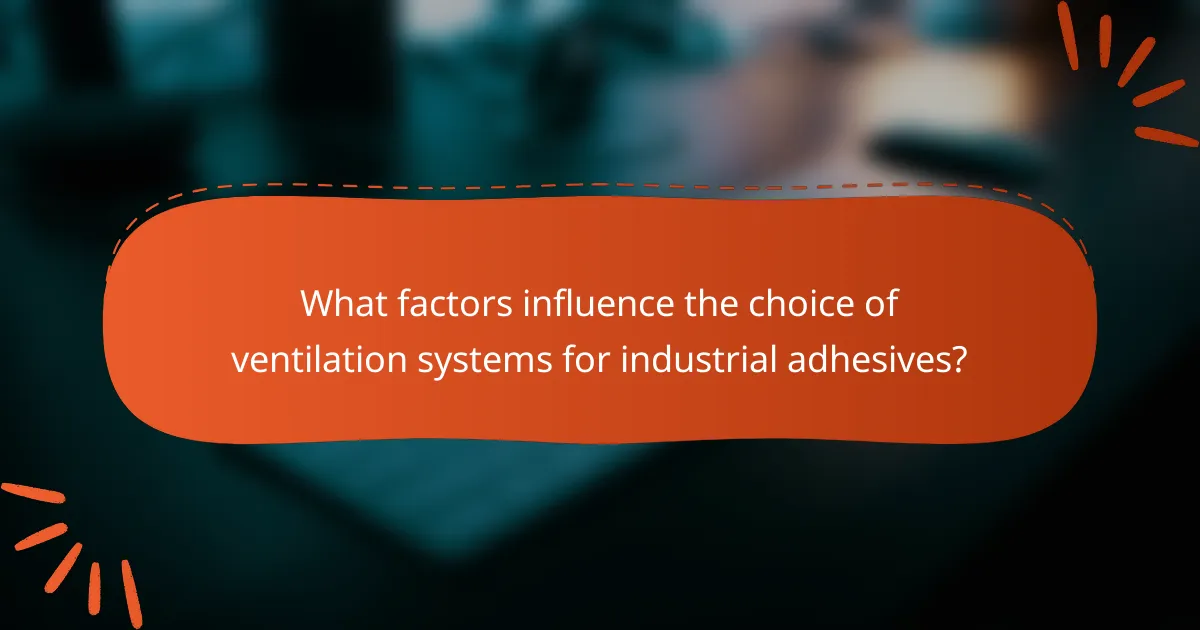
What factors influence the choice of ventilation systems for industrial adhesives?
The choice of ventilation systems for industrial adhesives is influenced by several key factors. These factors include the type of adhesives used, their chemical properties, and the associated health risks. Different adhesives release varying levels of volatile organic compounds (VOCs). The concentration of these VOCs affects the required ventilation capacity.
Additionally, the size and layout of the workspace play a significant role. Larger spaces may require more extensive systems to ensure adequate air exchange. The presence of heat and humidity can also impact system design. Systems must be capable of maintaining optimal temperature and humidity levels for adhesive performance.
Regulatory compliance is another critical factor. Industries must adhere to safety standards set by agencies such as OSHA. Finally, cost considerations influence the choice of system. Organizations often balance initial installation costs with long-term operational efficiency.
How do different adhesive types affect ventilation requirements?
Different adhesive types significantly affect ventilation requirements due to their chemical composition and curing processes. Solvent-based adhesives typically release volatile organic compounds (VOCs) that require increased ventilation to ensure safe air quality. Water-based adhesives, in contrast, emit fewer VOCs, resulting in lower ventilation demands. Hot melt adhesives generally produce minimal emissions, thus requiring the least ventilation. Adhesives with higher toxicity profiles, such as certain epoxy resins, necessitate stringent ventilation measures to mitigate health risks. Regulatory standards often dictate specific ventilation rates based on the adhesive type used. For example, the Occupational Safety and Health Administration (OSHA) recommends ventilation strategies based on the hazardous nature of the materials involved. Proper assessment of adhesive properties is crucial for establishing adequate ventilation systems in industrial settings.
What specific attributes of adhesives determine ventilation needs?
The specific attributes of adhesives that determine ventilation needs include volatile organic compound (VOC) content, curing time, and application method. High VOC levels require increased ventilation to prevent harmful exposure. Adhesives with longer curing times may emit fumes for extended periods, necessitating ongoing ventilation. The application method, such as spray or brush, also influences ventilation requirements. Spraying typically generates more aerosolized particles, increasing the need for effective air circulation. Thus, understanding these attributes helps ensure safe working environments when using adhesives.
How do environmental factors impact ventilation system selection?
Environmental factors significantly influence ventilation system selection. These factors include temperature, humidity, and air quality. For instance, high humidity levels may require systems that can effectively dehumidify the air. Extreme temperatures can dictate the need for heating or cooling capabilities in the ventilation system. Additionally, outdoor air quality impacts the choice of filtration systems to ensure clean indoor air. Local regulations and environmental standards also guide the selection process. Systems must comply with specific emissions and safety requirements. Overall, understanding these environmental factors is crucial for selecting an effective ventilation system.
What regulations govern ventilation in industries using adhesives?
Regulations governing ventilation in industries using adhesives are primarily outlined by the Occupational Safety and Health Administration (OSHA) and the Environmental Protection Agency (EPA). OSHA standards require adequate ventilation to minimize exposure to harmful chemicals in adhesives. These regulations specify permissible exposure limits for volatile organic compounds (VOCs) commonly found in adhesives. The EPA also enforces regulations regarding air quality standards that affect adhesive manufacturing processes. Compliance with these regulations ensures a safe working environment and reduces health risks associated with adhesive use.
What are the key standards and guidelines for ventilation systems?
Key standards and guidelines for ventilation systems include ASHRAE Standard 62.1 and OSHA regulations. ASHRAE Standard 62.1 specifies minimum ventilation rates for acceptable indoor air quality. It focuses on the amount of outdoor air required for various building types. OSHA regulations ensure worker safety and health in occupational environments. They provide guidelines for ventilation to control airborne contaminants. The National Fire Protection Association (NFPA) also offers standards for ventilation in relation to fire safety. Compliance with these standards helps maintain air quality and safety in industrial settings.
How can businesses ensure compliance with ventilation regulations?
Businesses can ensure compliance with ventilation regulations by conducting regular assessments of their ventilation systems. These assessments should evaluate airflow rates, air quality, and system efficiency. Organizations must also stay updated on local and national ventilation standards. Training staff on proper ventilation practices is crucial for maintaining compliance. Implementing a maintenance schedule for ventilation equipment helps prevent issues. Additionally, businesses should document all compliance efforts and inspections. This documentation serves as proof of adherence to regulations. Regularly reviewing and updating policies ensures ongoing compliance with changing regulations.

What best practices should be followed for effective ventilation in adhesive applications?
Effective ventilation in adhesive applications requires proper air exchange and contamination control. Ensure that the workspace has sufficient airflow to dilute and remove hazardous vapors. Use local exhaust ventilation systems to capture fumes at the source. Maintain a minimum air change rate as recommended by safety guidelines, typically around 6 to 12 air changes per hour. Regularly inspect and maintain ventilation systems to ensure optimal performance. Monitor air quality with appropriate sensors to detect harmful levels of volatile organic compounds. Compliance with OSHA and industry-specific standards is crucial for worker safety.
How can businesses optimize their ventilation systems for safety and efficiency?
Businesses can optimize their ventilation systems for safety and efficiency by conducting regular assessments and implementing advanced technologies. Regular assessments identify areas needing improvement. This includes checking airflow rates and ensuring proper air exchange. Advanced technologies such as demand-controlled ventilation adjust airflow based on occupancy and air quality. This can significantly reduce energy consumption. Additionally, using high-efficiency particulate air (HEPA) filters improves air quality by capturing harmful particles. Regular maintenance of ventilation systems prevents breakdowns and ensures optimal performance. Training staff on ventilation system operation enhances safety and efficiency. Implementing these strategies can lead to safer working environments and reduced operational costs.
What maintenance practices are essential for ventilation systems?
Regular inspection, cleaning, and filter replacement are essential maintenance practices for ventilation systems. Inspections should occur at least twice a year to identify any issues. Cleaning ducts and vents prevents dust accumulation and ensures efficient airflow. Filters must be replaced every 1-3 months, depending on usage. Additionally, checking for leaks in ductwork is crucial to maintain system efficiency. Testing airflow and pressure helps verify that the system operates within specifications. Regular maintenance can extend the lifespan of the ventilation system and improve air quality.
How can employee training enhance the effectiveness of ventilation systems?
Employee training can enhance the effectiveness of ventilation systems by ensuring proper operation and maintenance. Trained employees understand system components and their functions. This knowledge allows them to identify issues promptly. Regular maintenance can prevent system failures and inefficiencies. Training also emphasizes the importance of airflow management. Proper adjustments can optimize air quality and reduce contaminants. Furthermore, educated staff can implement safety protocols effectively. This reduces health risks associated with poor ventilation. Studies show that organizations with trained personnel experience better air quality outcomes.
What common challenges arise in managing ventilation for industrial adhesives?
Common challenges in managing ventilation for industrial adhesives include controlling volatile organic compounds (VOCs) emissions. VOCs can pose health risks and require effective air quality management. Another challenge is ensuring adequate airflow to prevent the buildup of harmful fumes. Insufficient airflow can lead to hazardous working conditions. Additionally, the variability in adhesive formulations can complicate ventilation needs. Different adhesives may release different levels of fumes, necessitating tailored ventilation solutions. Maintenance of ventilation systems is also critical. Regular checks are needed to ensure systems operate efficiently. Lastly, regulatory compliance can be challenging. Industries must adhere to strict air quality standards, which can vary by region.
How can businesses troubleshoot ventilation issues effectively?
Businesses can troubleshoot ventilation issues effectively by conducting a thorough assessment of their ventilation systems. Start by checking for blockages in ducts and filters. Inspect fans and blowers to ensure they are functioning properly. Measure airflow rates to confirm they meet industry standards. Evaluate the placement of vents and exhausts to ensure optimal air distribution. Monitor indoor air quality using sensors to detect pollutants. Regular maintenance of equipment is essential to prevent future issues. Documentation of past ventilation problems can help identify patterns and solutions. Implementing these steps can enhance air quality and compliance with safety regulations.
What steps can be taken to improve air quality in existing systems?
Implementing enhanced filtration systems is crucial to improve air quality in existing ventilation systems. Upgrading to HEPA filters can effectively capture particulate matter. Regular maintenance of filters ensures optimal performance and longevity. Increasing air exchange rates can dilute contaminants more efficiently. Utilizing air purifiers can further reduce airborne pollutants. Monitoring indoor air quality with sensors helps identify specific issues. Adjusting humidity levels can prevent mold growth and improve overall air quality. Educating staff on proper ventilation practices promotes a healthier work environment.
Ventilation needs for industrial adhesives are critical for ensuring worker safety and maintaining air quality. The article outlines the importance of adequate ventilation to dissipate harmful fumes and vapors, the types of ventilation systems available, and the health risks associated with inadequate airflow. It also covers how different adhesive types influence ventilation requirements and the regulations governing these systems. Additionally, best practices for optimizing ventilation, monitoring air quality, and troubleshooting common challenges are discussed to enhance workplace safety and compliance.
